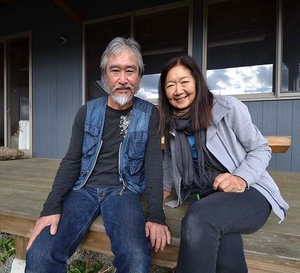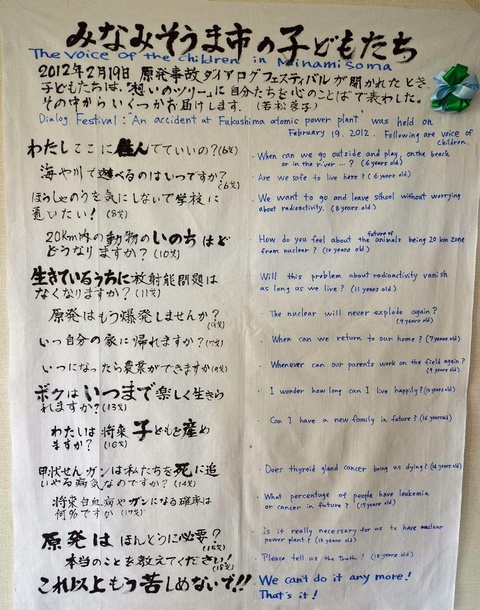Read Part 2 >>
THE NUMBER OF CLOTH LETTERS KEEP GROWING...
In June 2011 Canadian Cloth Letters there were two large cloth letters (which were later divided into 3 cloth letters). By October 2011 at the Tokyo exhibition of Canada and Tohoku cloth letters there were 11.
Today, as of Dec. 2012, we will have about 24 cloth letters ready for the Tohoku Tour (with more adding on as it goes).
In Canada, Alberta Premier Christy Clark and Prime Minister Harper expressed warm responses to the Cloth Letters. The Canadian Ambassador in Japan used the cloth letters as his official Christmas card last year.

This is an example of a cloth letter presentation from Tohoku area. This is with the Yuriage Junior High School students who lost their school and 14 of their classmates. They were in a temporary shared elementary school in a nearby town last year, and now have been moved to a small school of their own. Many of the schools that were lost ended up in cramped quarters as they moved into other nearby schools. Most of them are still in the temporary school set-ups.
You want to bring it over to Canada in 2013. Where and when will Canadians be able to see it?
We are hoping to find exhibition spaces across Canada. We tried hard in Calgary, but did not find any place that would take it. It may have to begin within Japanese Canadian communities, but I was trying for the cities.
There have been inquiries from the USA: Detroit, New York City, San Francisco and Alaska. It would be a shame for these cloth letters to do more American cities than Canadian.
LINDA'S NEW DOCUMENTARY FILM PROJECT
Can you talk a bit about the film project? What is it? Why did you decide to take it on? What do you need now to make it happen?

Evacuated area of Fukushima....with one of the amazing people that Linda is following for her documentary. First she met him in the evacuated area near Minamisoma and near the Daiichi Nuclear Plant. She has interviewed him twice now. First time in summer 2012 and again in October 2012. Amazingly after their first meeting, at the end of that day they discovered that they have a mutual Japanese friend in Vancouver. They were caught by that magic.
I have been actively involved in supporting Tohoku’s recovery from the massive earthquake and tsunami disaster since March 11, 2011 as a Nikkei Canadian with projects based in Vancouver, across Canada, the USA, and in Tohoku. I became involved as a mother, grandmother and a Nikkei Canadian; not as a filmmaker.
For the past 18 months, I have spent much time as a volunteer throughout Tohoku and have had the privilege of meeting and being inspired by many people as they deal with their loss and their recovery.
What inspires the spirit to hold on to their dreams? What is really behind that beautiful 'Tohoku smile'?
Although it was not my original intention to make a documentary film, after this volunteer experience with the Tohoku people, the filmmaker in me came to the surface while I visited ghost towns in the evacuated area 25 km from the Fukushima Daiichi Nuclear Power Plant. Being inside these deserted towns made me realize that I have another responsibility with my profession as a filmmaker. I can volunteer with my hands by helping to dig out rubble, but my real talent that is rarer is as a documentary filmmaker. This is the way I can volunteer now with my real skills and profession and sensitivities.
And throughout Tohoku, so many Tohoku people have asked me to please make a documentary about their story for the world to know.
“Tohoku no Shingetsu: Stories from Iwate, Miyagi and Fukushima” will highlight some of the stories of recovery in Tohoku that may inspire change in the lifestyle we live in our own lives, to help make a better and safer world to live in.
The Tohoku people may have been left with almost nothing but there is a Buddhist prayer that says “everything is nothing; and nothing is everything.” The Tohoku people are living this reality and are proof that although painfully slow, recovery of their lives is possible.
Any personal stories of your work over there to help us understand what life has been like for you over the past year or so?
It has been every extreme that I have known. Some so beautiful, it brought tears to me. And some so difficult that I asked myself why don't I just go back home to Canada. And sometimes, the hours and language and culture are exasperating and I miss my family (in Vancouver, BC) very much. But, as I travel through Tohoku with the Tohoku people and meet their families, I can see my own grandchildren and children in them and I know why I have to stay and try and help in what ways that I can.
And the big reality is that volunteering costs money. You have to pay to be a volunteer. Pay your own way with your own time and resources. As this is what I have been doing since beginning organizing the Ganbare Japan benefit concert in Vancouver, it has been a long haul.
I am not complaining because I have met some great people and been inspired by much.
But the reality is that food and shelter and travel costs money in our world. And that has been my biggest challenge in Tohoku. There have been days when I nervously look into my wallet and discover that I only have a few hundred yen (less than $10) and a Canadian passport. But I have been able to do it. Some weeks, I eat a lot of brown rice and oatmeal sprinkled with raisins from home, but, heh, there are others who eat less than that in this world! Basically, I have been able to keep healthy so no worries.
Fortunately, I have a lot of support in Japan from my history of giving university lectures prior to the tsunami earthquake. With this lucky reputation, I have been able to get a string of lectures now and then to support my volunteering in Tohoku.
As for making the documentary, I am being forced to do some producing through online support.
Anyone who wants to help support my making of "Tohoku no Shingetsu" can help me make this film can go to the "Indiegogo" funding site, under my name or "Tohoku no Shingetsu". Seriously speaking, I could use some help to make this film. You can always be sure that I am not wasting the funds and overspending. Those who know me, know that I am efficient, frugal, but always finish with professional, high quality results. This does take some money, but I feel that this is a film worth getting behind and I am in the position to be able to do it. So please help!
My tip for anyone who does extensive long-term overseas volunteering: think about what you can really do. My passion and energy is high, but not everyone can do it. We are all made differently and can contribute to Tohoku, the world, and the future in different ways. Not everyone needs to become a volunteer.

Onagawa young taiko group who lost everything in the tsunami were given a donation earned by Vancouver taiko groups who had a Taiko benefit concert in spring of 2012 in Vancouver.
What is the best way that Canadians can help now?
I cannot answer this for Canadians. I have given some ways above and also on my website at www.lindaohama.com. In the end, each of us as human beings must take some responsibility and act upon it in whatever way that we know how, not just talk about it, but get involved. We are all part of one world, a world that is not so big. And one that needs a lot of attention as we head into our future.

[CLICK TO ENLARGE]. This is a cloth letter that Linda recently received from the young people of Minamisoma, Fukushima with their package of 100 cloth letters they created for her cloth letters exhibition.
* Please check latest updates at: Tohoku no Shingetsu Film Project
© 2012 Norm Ibuki






